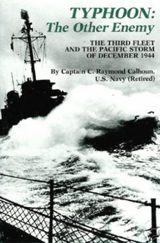

On 18 December 1944, Adm. Halsey’s Third Fleet crossed paths with a typhoon that sank Hull, Monaghan and Spence nearly sank Dewey, Aylwin and Hickox.
In 1981, Dewey’s then-commanding officer C. Raymond Calhoun wrote Typhoon: The Other Enemy, a definitive account and analysis of her stability problems, her recovery from a sustained roll of more than 75°, the loss of other ships and follow-on events.
After two training cruises to Guantánamo Bay, Cuba, and Port-au-Prince, Haiti, Dewey sailed from Norfolk on 1 April 1935 for San Diego, Calif., arriving 14 April. Until 1938 she operated principally from this port on local operations as well as engaging in fleet tactics battle practice, and scheduled exercises. She cruised along the west coast as far north as Alaska and south to Callao, Peru, and made three cruises to the Hawaiian area. From 4 January to 12 April 1939 she returned to the Atlantic for a fleet problem. Dewey arrived at Pearl Harbor 12 October 1939 and participated in tactical exercises, battle practice, fleet problems, and maneuvers until 1941.
When the Japanese attacked Pearl Harbor 7 December 1941, Dewey was undergoing tender overhaul. She immediately took the enemy planes under attack and that afternoon got underway to patrol in the Hawaiian area. On 15 December she joined TF 11 sailing to relieve the beleaguered Marine garrison on Wake Island, but the island fell 23 December and Dewey returned to her patrol assignment.
In February 1942 she rejoined TF 11 for a projected strike on Rabaul. The element of surprise was lost when the force was sighted by two enemy patrol planes and the strike was canceled after Dewey aided in splashing several of 18 bombers led to the force by radio reports from the patrol planes. She continued to screen Lexington (CV-2) in the strikes on Lae and Salamaua, New Guinea, on 10 March and returned to Pearl Harbor on the 26th.
TF 11 sortied from Pearl Harbor 15 April 1942 for operations in the Solomons. On 5 May word came that the Japanese were advancing on Port Moresby, and Dewey's group raced to join Yorktown (CV-5) in the Battle of the Coral Sea. In this great strategic victory, the Japanese were at last turned back from the advance southeastward, Australia and New Zealand were spared from threatened invasion, and carrier warfare came of age as for the first time major fleets battled without surface contact. When Lexington came under intensive attack, Dewey joined in sending up antiaircraft fire which splashed or drove off many of the attackers, suffering five men wounded from enemy strafing. Lexington was badly hit, and as fires raged out of control, she had to be abandoned, with Dewey rescuing 112 of the carrier's survivors. She screened Yorktown into Nouméa 12 May, and then returned to Pearl Harbor 26 May in the screen for Enterprise (CV-6). (continued)